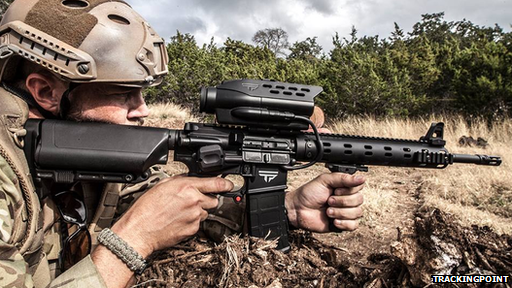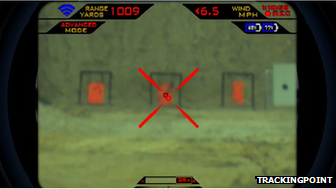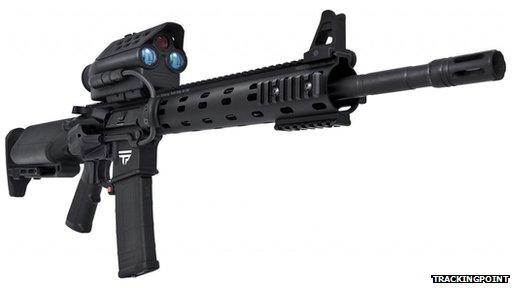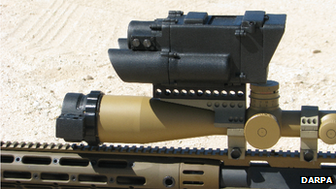US Army tests TrackingPoint smart-rifle scopes
- Published

TrackingPoint weapons are equipped with a special scope featuring a head-up display
The US Army is testing a "smart rifle" technology designed to improve the accuracy of shots.
A spokeswoman confirmed reports that, external its equipment testing specialists had acquired six TrackingPoint rifles as part of efforts to identify state-of-the-art kit.
The tech allows the user to place a virtual tag on a target seen through the weapon's scope.
If the trigger is pressed, it fires only if the gun is correctly lined up.
This prevents errors such as trigger jerk, range miscalculation and accidental firing from being a problem.
In addition, a Linux-based computer built into the scope can compensate for 16 calculated variables, including temperature, the expected spin drift of the bullet and the direction the wind is blowing.

A TrackingPoint weapon is supposed to refuse to fire until a red dot is lined up with a tagged target
"I can only train a soldier so much," Lt Col Shawn Lucas, of the army's Program Executive Office (PEO) soldier division, told Army Times, external.
"However, for a relatively small investment, I can make a significant increase in probability of hit and overall effectiveness by making an investment in advanced fire control."
But one independent observer said the technology would not turn every soldier into a sniper.
"This isn't a revolutionary technology, but essentially laser-designation 'tagging' adapted from common use in more complex weapons systems for use on small arms," said Peter Quentin, of the defence-focused Rusi think tank.
"It is not going to create 'super-snipers' because it still cannot do what is the truly smart aspect of their skills - a full assessment of weather and other conditions that will affect the flight of the bullet, and [which] therefore requires considerable calculation to determine adjustments to the aim.
"But while this does not deepen capabilities, it has the potential to broaden them, improving the accuracy of larger numbers of less specialist personnel by enabling the 'retagging' of a target rather than retaking of a shot."
Precision tactics
According to the Austin, Texas-based company TrackingPoint, the addition of its scope to a rifle delivers five times the first-shot success rate of traditional systems at distances of up to 1,200 yards (1.1km).

The scopes use a laser range finder to lock onto a moving target
An associated app can also stream live video from the scope's head-up display to a smartphone or tablet - allowing the shooter's tags to be monitored.
Civilian versions of its shooting systems cost between $10,000 and $27,000 (£6,030 to £16,280), depending on the weapon used.
"We believe this technology will revolutionise the effectiveness of our fighting forces as they perform their duty for our country," chief executive John Lupher told the BBC.
The company is not the only one trying to make gunfire more accurate.
The Pentagon's Darpa research unit is developing a separate sniper scope, external called the One Shot XG that measures crosswinds gusting up to 54km/h (33.6mph), the range to the target and a resulting confidence score.

Darpa is developing its own "smart" sniper scope to improve the accuracy of shots
Lockheed Martin is taking a different approach by developing self-guiding bullets, external that can steer themselves towards a target by using tiny fins to adjust their course mid-air in order to hit laser-designated targets at distances of more than a mile.
Mr Quentin suggested the demand for such technologies was growing because of a tactical shift away from the use of suppression fire, used to fix an enemy in one position, towards a precision model.
"Precision is required when operating amongst populations, such as Afghanistan, where targets must be positively identified and civilian casualties avoided at all costs," he said.
"In such environments first-time hits and avoidance of collateral damage are paramount - it is not just about what you hit, but who you miss.
"Such systems, therefore, offer the potential to broaden the capability of forces to deliver accurate fire on positively identified targets, but ultimately they can only be as smart as the personnel that operate them."
- Published6 May 2013
- Published8 March 2012
- Published11 April 2011